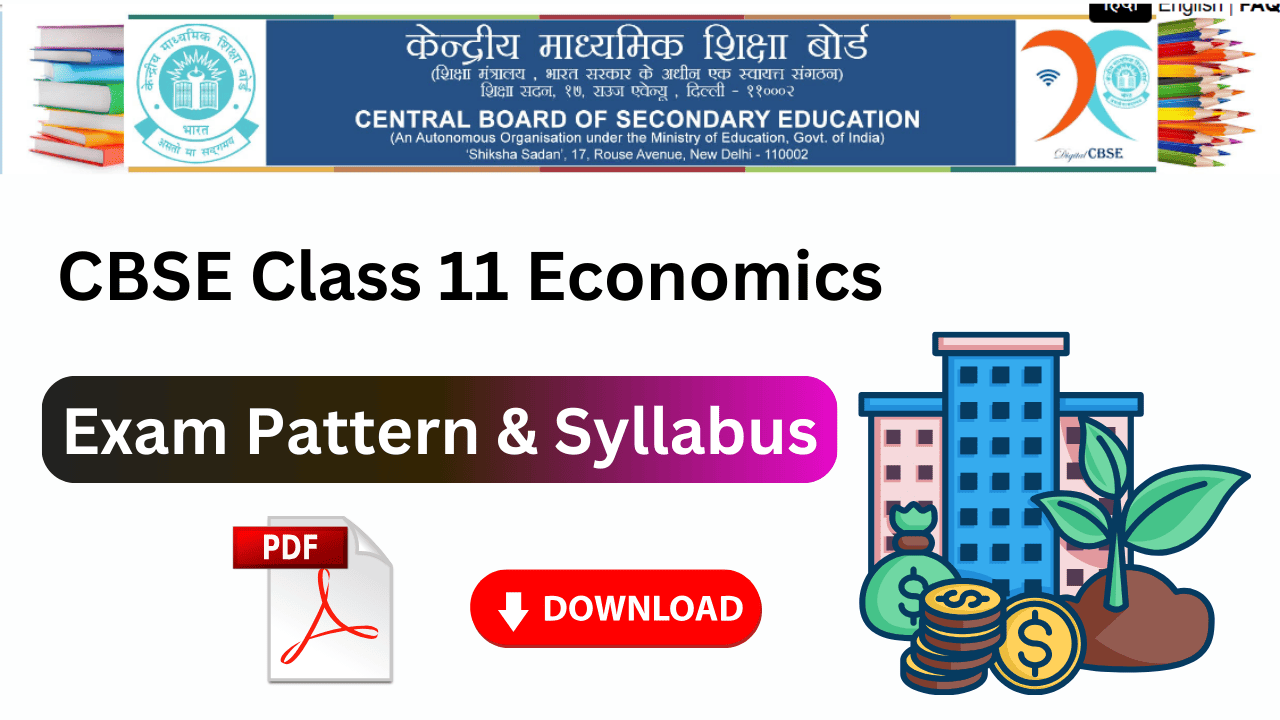Updated CBSE Class 11 Economics Syllabus for 2025-26 – Get the latest chapter-wise syllabus, marking scheme, and study tips. Download the official PDF at the end!
Overview of CBSE Class 11 Economics Syllabus 2025-26
The Class 11 CBSE syllabus for Economics plays a crucial role in board exams and competitive exams like CUET. This year, CBSE has introduced competency-based questions and a revised weightage system to encourage conceptual learning over rote memorization.
| Board | CBSE |
| Class | 11 |
| Session | 2025-26 |
| Subject | Economics |
| Content-Type | Syllabus/Curriculum |
| Official Website | https://cbseacademic.nic.in |
ECONOMICS (Subject Code: 030)
ECONOMICS (030) - CLASS XI (2025-26) MARKING SCHEME
| Component | Marks | Duration |
|---|---|---|
| Theory | 80 | 3 Hours |
| Project | 20 | - |
| Total | 100 |
Part A: Statistics for Economics (40 marks)
| Unit | Topic | Marks |
|---|---|---|
| 1 | Introduction | |
| 2 | Collection, Organisation and Presentation of Data | 15 (Including Introduction) |
| 3 | Statistical Tools and Interpretation | 25 |
| Total Part A | 40 |
Part B: Introductory Microeconomics (40 marks)
| Unit | Topic | Marks |
|---|---|---|
| 4 | Introduction | 4 |
| 5 | Consumer's Equilibrium and Demand | 14 |
| 6 | Producer Behaviour and Supply | 14 |
| 7 | Forms of Market and Price Determination under perfect competition with simple applications | 8 |
| Total Part B | 40 |
Part C: Project Work (20 marks)
Part A: Statistics for Economics (40 Marks)
Unit 1: Introduction (15 Marks)
- What is Economics?
- Statistics in Economics
- Meaning, scope, functions, and importance
Unit 2: Collection, Organisation, and Presentation of Data (25 Marks)
Collection of Data
- Sources: Primary & Secondary
- Sampling concepts
- Methods of data collection
- Key secondary sources: Census of India, NSSO
Organisation of Data
- Types of variables
- Frequency Distribution
Presentation of Data
- Tabular Presentation
- Diagrammatic Presentation
- Geometric Forms: Bar & Pie Diagrams
- Frequency Diagrams: Histogram, Polygon, Ogive
- Arithmetic Line Graphs: Time Series Graph
Unit 3: Statistical Tools and Interpretation (25 Marks)
Measures of Central Tendency
- Mean, Median, Mode
Correlation
- Meaning & properties
- Scatter Diagram
- Karl Pearson’s Method (Ungrouped data)
- Spearman’s Rank Correlation (Repeated & Non-Repeated Ranks)
Index Numbers
- Meaning & types: WPI, CPI, IIP
- Uses of index numbers
- Inflation & Index Numbers
- Simple Aggregative Method
Part B: Introductory Microeconomics (40 Marks)
Unit 4: Introduction (4 Marks)
- Micro vs. Macroeconomics
- Positive vs. Normative Economics
- Central Problems of an Economy (What, How, For Whom to Produce)
- Production Possibility Frontier (PPF) & Opportunity Cost
Unit 5: Consumer's Equilibrium and Demand (14 Marks)
Consumer’s Equilibrium
- Utility & Marginal Utility
- Law of Diminishing Marginal Utility
- Indifference Curve Analysis (Budget Set, Budget Line, IC, Conditions)
Demand Analysis
- Demand Schedule & Curve
- Movement vs. Shift in Demand Curve
- Price Elasticity of Demand (Factors & Measurement)
Unit 6: Producer Behaviour and Supply (14 Marks)
Production Function
- Short-Run vs. Long-Run
- TP, AP, MP
- Returns to a Factor
Cost Concepts
- TC, TFC, TVC, AC, AFC, AVC, MC (Meaning & Relationships)
Revenue Concepts
- TR, AR, MR (Meaning & Relationships)
Producer’s Equilibrium
- MR = MC Condition
Supply Analysis
- Supply Schedule & Curve
- Movement vs. Shift in Supply Curve
- Price Elasticity of Supply (Measurement)
Unit 7: Perfect Competition (8 Marks)
- Features of Perfect Competition
- Market Equilibrium & Shifts in Demand/Supply (Short Run)
- Applications: Price Ceiling & Price Floor
Part C: Project Work (20 Marks)
- Practical application of economic concepts
- Data collection, analysis, and presentation
Question Paper Design for March 2026 Examination
| Marks: 80 | Duration: 3 Hours |
|---|
Question Paper Blueprint
| S.No. | Typology of Questions | Marks | Percentage | Description |
|---|---|---|---|---|
| 1. | Remembering & Understanding | 32 | 40% | - Recall facts, terms, basic concepts - Demonstrate understanding through organization, comparison, interpretation |
| 2. | Applying | 24 | 30% | - Solve problems in new situations - Use acquired knowledge in different contexts |
| 3. | Analyzing, Evaluating & Creating | 24 | 30% | - Break down information, identify patterns - Make judgments, defend opinions - Propose alternative solutions |
| Total | 80 | 100% |
Download CBSE Class 11 Economics Syllabus 2025-26 PDF
Click the button below to download the official CBSE syllabus PDF for 2025-26.
📂 Download CBSE Class 11 Economics Syllabus PDF
Related Guides
CBSE Class 11 Syllabus – All Subjects
Stay Updated!
Join our Telegram/WhatsApp group for CBSE updates, free notes, and exam tips!
Bookmark this page & keep revising smartly!
